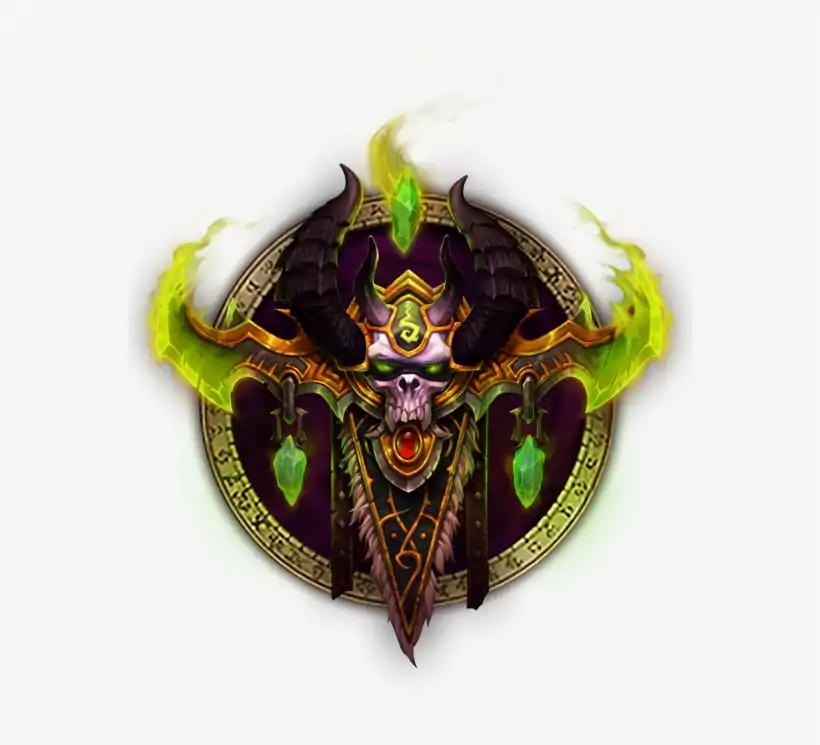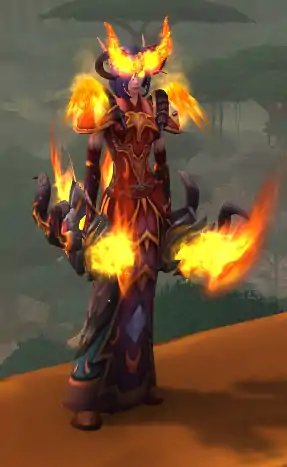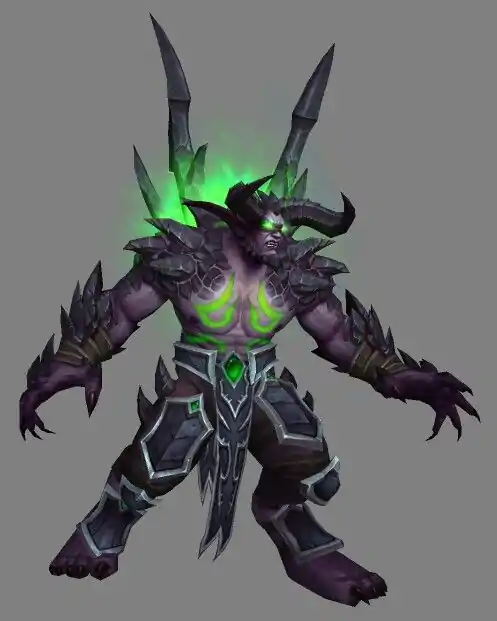Demon Hunter, Variant (5e Class)
Creating a Demon Hunter
Demon hunters, disciples of Illidan Stormrage, uphold a dark legacy, one that frightens their allies and enemies alike. The Illidari embrace fel and chaotic magics—energies that have long threatened the world of Azeroth—believing them necessary to challenge their greatest foes. Wielding the powers of demons they’ve slain, they develop demonic features that incite revulsion and dread in both their allies and their enemies. Dexterous and deadly, the demon hunter turns the twisted power of the Abyss against it. Drawing on fel forces to fuel their attacks, Demon Hunters pursue their prey with uncanny agility, dodging away from danger and closing on enemies in the blink of an eye. Whether wielding their powers for good or evil, these deadly warriors are forces to be reckoned with.
Quick Build
 |
|---|
| {{{3}}} |
You can make a demon hunter quickly by following these suggestions. First, Dexterity should be your highest ability score, followed by Intelligence and Constitution. Second, choose the soldier background.
Class Features
As a Demon Hunter you gain the following class features.
- Hit Points
Hit Dice: 1d8 per Demon Hunter level
Hit Points at 1st Level: 8 + Constitution modifier
Hit Points at Higher Levels: 1d8 (or 5) + Constitution modifier per Demon Hunter level after 1st
- Proficiencies
Armor: None
Weapons: Simple weapons, longswords, rapiers, and shortswords
Tools: Alchemist's tools, thieves' tools
Saving Throws: Dexterity, Intelligence
Skills: Choose two from Acrobatics, Athletics, Deception, Intimidation, Perception, and Stealth.
- Equipment
You start with the following equipment, in addition to the equipment granted by your background:
- (a) Dungeoneer's pack or (b) Explorer's pack
| Level | Proficiency Bonus | Features |
|---|---|---|
| 1st | +2 | Illidari Glaives,Mark of the Demon Hunter |
| 2nd | +2 | Fighting Style |
| 3rd | +2 | Hunter Archetype |
| 4th | +2 | Ability Score Improvement |
| 5th | +3 | Extra Attack |
| 6th | +3 | Metamorphosis |
| 7th | +3 | Blade Dance |
| 8th | +3 | Ability Score Improvement |
| 9th | +4 | — |
| 10th | +4 | Blind but not Deaf |
| 11th | +4 | Metamorphosis Improvement,Mark of the Demon Hunter Improvement |
| 12th | +4 | Ability Score Improvement |
| 13th | +5 | — |
| 14th | +5 | Glaive Throwing |
| 15th | +5 | — |
| 16th | +5 | Ability Score Improvement |
| 17th | +6 | Blind but not Deaf Improvement |
| 18th | +6 | — |
| 19th | +6 | Ability Score Improvement |
| 20th | +6 | Master of Metamorphosis |
Mark of the Demon Hunter
Demon Hunters are marked with tattoos that grant them protection against their foes. While you are wearing no armor and not wielding a shield, your AC equals 10 + your Dexterity modifier + your Intelligence modifier.
You have advantage on Wisdom (Survival) checks to track Fiends, as well as on Intelligence checks to recall information about them. If you are actively tracking Fiends, you cannot be surprised by any Fiend. You can only be tracking one type of creature at a time, Add your Competence modification for this checks.
Upon reaching 11th level, you can use scars pain to give clarity, or promote anger. Gain advantage on a Wisdom (Insight) check or Charisma (Intimidation) check versus Fiends.
Illidari Glaives
At 1st level, you can summon glaives made of dark energy. As a bonus action, you can conjure a glaive into each of your hands if the hand isn't holding anything. You are proficient in the glaives. They are martial melee weapons that deal 1d6 slashing damage on a hit plus a 1d4 necrotic damage, and they have the Light and Finesse properties. At will, you can dismiss a glaive that you have conjured. The necrotic damage bypasses resistance. Improves the damage dice to 1d6 in lv5, 1d8 to lv11 and 1d10 in lv17.
Fighting Style
At 2nd level, you adopt a style of fighting as your specialty. Choose one of the following options. You can’t take a Fighting Style option more than once, even if you later get to choose again.
Archery: You gain a +2 bonus to attack rolls you make with ranged weapons.
Defense: While you are not wearing armor, you gain a +1 bonus to AC.
Protector: When a creature you can see attacks a target other than you that is within 5 feet of you, you can use your reaction to impose disadvantage on the attack roll. You must be wielding a shield.
Two-Weapon Fighting: When you engage in two-weapon fighting, you can add your ability modifier to the damage of the second attack.
Gathering Steps: When you are wielding a melee weapon in one hand and no other weapons, the weapon you are wielding is considered to have the reach property, if it does not have it already.
Hunter Archetype
At 3rd level, you choose an archetype that you emulate in the exercise of your Hunter abilities: the HellFire Slayer, the Vengeance, or the Shadowcaster , all detailed at the end of the class description. Your archetype choice grants you features at 3rd level and then again at 9th, 13th, and 18th level.
Ability Score Increase
When you reach 4th level, and again at 8th, 12th, 16th and 19th level, you can increase one ability score of you choice by 2, or you can increase two ability scores of your choice by 1. As normal, you can't increase an ability score above 20 using this feature.
Extra Attack
Beginning at 5th level, you can attack twice, instead of once, whenever you take the Attack action on Your turn.
Metamorphosis
Starting at 6th level, the Demon Hunter can transform into Demonic form as an action. This form lasts for 10 minutes. You can speak, use equipment, and wear armor in this form. You can revert to your normal form earlier by using an action on your turn. You automatically revert to your normal form if you fall unconscious, drop to 0 hit points, or die.
You can use this feature twice. You regain expended uses when you finish a short or long rest. While you are transformed, you gain the following features:
- You are resistant to bludgeoning, piercing, and slashing damage from non-magical weapons.
- As an action, you can inflict fear within a creature you can see within 60 feet of you. That creature must succeed on a DC 15 Wisdom saving throw or become frightened for 1 minute. A creature can repeat the saving throw at the end of each of its turns, ending the effect on itself on a success. If a creature's saving throw is successful or the effect ends for it, the creature is immune to this effect for 24 hours.
- Your weapon attacks with your Glaives deal an additional 1d6 necrotic damage with each hit.
- Your appearance changes into that of a demon (Horns, bat wings, demon tail).
- Your creature type is considered to be Fiend (demon) for all effects.
Starting at 11th level, you learn to unleash and control more of the pits and get
- You gain a bonus to melee attack and damage rolls made with your Glaive equal to half of your proficiency bonus (rounded down).
- Your speed increases by 10 feet. You also can add 10 feet to your long jump distance and 3 feet to your high jump distance.
- You can use this transformation three times. You regain expended uses when you finish a short or long rest.
- Your AC is improved +1.
Blade Dance
Starting at 7th level, your glaives dance between foes and easily slay them. Whenever you reduce a creature to 0 HP with an attack using your glaive, you may immediately make a glaive attack against each other creature within 5 feet of you.
Blind but not deaf
At Lv 10 you gain blind sense 15 'if you already had sense blind improves up to 30'. to Lv 17, increase the range of your sense by another 15 '
Glaive Throwing
At 14th level, your glaives become throwing weapons that can kill from a distance. Your glaives gain the Thrown and Range (30/120 ft.) properties. When you throw one of your glaives, it automatically returns to your hand after the attack.
Master Metamorphosis
At 20th level you can keep your demonic form as long as you like and once on each of your turns, you can add your Int modifier to the attack roll or the damage roll of an attack you make against a evil outsider. You can choose to use this feature before or after the roll, but before any effects of the roll are applied. In addition, when you critically hit with a weapon attack you can take an additional attack this turn
Demon Hunter Archetypes
Demon hunters have many features in common, including their emphasis on perfecting their skills, their precise and deadly approach to combat, and their increasingly quick reflexes. But different Hunters steer those talents in varying directions.
Your choice of archetype is a reflection of your focus—not necessarily an indication of your chosen profession, but a description of your preferred techniques.
HellFire Slayer
 |
|---|
| HellFire Slayer |
The fel energies you wield have permeated your flesh, forging demon and person into a master of dealing death.
Demon Skin
At 3rd level, your skin is hardened by the powers of the pits Fire, you are immune to the fire damage. If you receive a fire attack you're granted a +1 AC until the start of you next turn
Hateful Immolation
Starting at 9th level, you can rebuke a foe who strikes you with burning, fiendish magic. When a creature atack you with a melee attack, you may use your reaction to burn that creature. It must make a Dexterity saving throw, taking 2d10 fire damage on a failure, or half as much on a successful one. The DC of the saving throw is equal to 8 + your proficiency bonus + your Intelligence modifier.
you can use this ability a number of times a day equal to your Intelligence Modifier
Fire Cloak
Beginning at 13th level, your very body is in tune with the Hellfire. When you use your glaives to attack a creature that can't see you, if the attack hits, it deals an additional 2d6 necrotic damage.
Soul Cleaver
At 18th level, you drink in the souls of foes you slay. When you kill a creature with an attack using your glaives, you gain 2d8 temporary hit points. These temporary hit points last for 1 hour.
Vengeance
 |
|---|
| Vengeance |
You are an incarnation of despair in the foes you slay. When you decide to end a life, nobody and nothing will get between you and their dead body.
Demon Skin
At 3th level,Your demon skin gives you inmunity for a Necrotic and Fire damage, in Devil Form your AC never is less than 18
Soul Shielder
Starting at 9th level, the Vengeance aid you can provide supernatural protection to those you defend. If you are in your demon form and another creature you can see within 30 feet of you takes damage, you can use your reaction to reduce that damage by 2d6. When you reach certain levels in this class. you can reduce the damage by more: by 3d6 at 12th level and by 4d6 at 15th level.
Durable mith
At 13th level Your Hit Dice change to 1d10, in the Demon Form you have resistance to all damage except radiant damage.
Vengeful Retreat
At 18th level, you can punish your enemies even when you're outmatched. As an action, you can move up to 30 ft. in a straight line away from a hostile creature you can see. This movement does not provoke opportunity attacks. In addition, you may make a glaive attack against every creature within 30 feet of your original position.
Once you use this feature a number of times equal to your intelligence modifier you can't use it again until you complete a short or long rest.
Shadowcaster
 |
|---|
| Abysmalcaster |
You have devoted yourself to a dark patron, siphoning arcana and ancient lore from their great power.
| Proficiency | —Spell Slots per Spell Level— | ||||||
|---|---|---|---|---|---|---|---|
| Level | Cantrips | Spell | 1st | 2nd | 3rd | 4th | 5th |
| 3rd | 2 | 3 | 2 | — | — | — | — |
| 4th | 2 | 3 | 2 | — | — | — | — |
| 5th | 3 | 4 | 4 | 2 | — | — | — |
| 6th | 3 | 4 | 4 | 2 | — | — | — |
| 7th | 3 | 5 | 4 | 3 | — | — | — |
| 8th | 3 | 5 | 4 | 3 | — | — | — |
| 9th | 3 | 6 | 4 | 3 | 2 | — | — |
| 10th | 4 | 6 | 4 | 3 | 2 | — | — |
| 11th | 4 | 7 | 4 | 3 | 3 | — | — |
| 12th | 4 | 7 | 4 | 3 | 3 | — | — |
| 13th | 4 | 8 | 4 | 3 | 3 | 1 | — |
| 14th | 4 | 8 | 4 | 3 | 3 | 1 | — |
| 15th | 5 | 9 | 4 | 3 | 3 | 2 | — |
| 16th | 5 | 9 | 4 | 3 | 3 | 2 | — |
| 17th | 5 | 10 | 4 | 3 | 3 | 3 | 1 |
| 18th | 5 | 10 | 4 | 3 | 3 | 3 | 1 |
| 19th | 5 | 11 | 4 | 3 | 3 | 3 | 2 |
| 20th | 5 | 11 | 4 | 3 | 3 | 3 | 2 |
Pact Magic
When you reach 3rd level, you have learned to channel the power of your pact to cast spells.
- Cantrips
You'll learn two cantrips of your choice from the warlock spell list. You learn an additional warlock cantrip of your choice at 5th, 10th und 15th level.
- Spell Slots
The Shadowcaster Spellcasting table shows many spell slots you have. The table also shows what the level those of those spell slots; all of your spell slots are the same level. To cast one of your Shadowcaster spells of 1st level or higher, you must expend a spell slot. You regain all expended spell slots when you finish a short or long rest.
- Spells Known of 1st-Level and Higher
You know three 1st-level warlock spells of your choice. The Spells Known column of the Shadowcaster Spellcasting table shows when you learn more warlock spells of 1st level or higher. Whenever you gain a level in this class, you can replace one of the warlock spells you know with another spell of your choice from the warlock spell list. A spell you choose must be of a level no higher than what’s shown in the table's Slot Level column for your level.
- Spellcasting Ability
Intelligence is your spellcasting ability for your shadowcaster spells, so you use your Intelligence whenever a spell refers to your spellcasting ability. In addition, you use your Intelligence modifier when setting the saving throw DC for a shadowcaster spell you cast and when making an attack roll with one.
Spell save DC = 8 + your proficiency bonus + your Intelligence modifier
Spell attack modifier = your proficiency bonus + your Intelligence modifier
Arcane Glaives
When you choose the Shadowcaster archetype at 3rd level, you gain the ability to channel magic through your glaives. Your glaives act as arcane foci for the purposes of casting Shadowcaster spells.
Deadly Spells
Beginning at 9th level, your spells have dark power behind them. You add your Intelligence modifier to the damage rolls of your Shadowcaster cantrips.
Sword and Spell
Starting at 13th level, you can mix your blades and magic together in a storm of death. When you use your action to cast a spell of 1st level or higher, you may make a weapon attack with your glaives as a bonus action.
Mastered Arcana
At 18th level, your magic has become utterly ingrained in you. Choose a 1st or 2nd-level spell that you know. You can cast that spell at will. You can change the chosen spell during a long rest by spending 1 hour meditating and gathering magic through your connection with your patron.
Back to Main Page → 5e Homebrew → Classes


